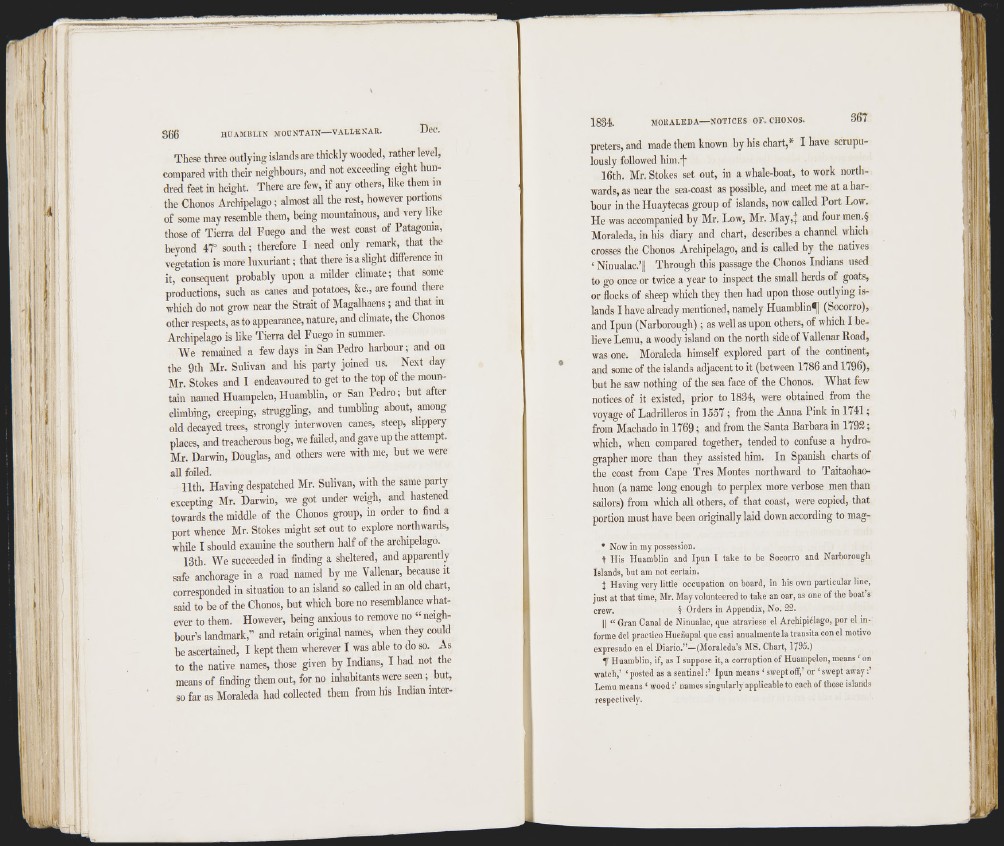
i i l
■}.
I'
I".
! (,
t i
366 HUAMBLIN MOUNTAIN VALLENAK. Dec.
These three outlying islands are thickly wooded, rather level,
compared with their neighbours, and not exceeding eight hundred
feet in height. There are few, if any others, hke them m
the Chonos Archipelago; almost all the rest, however portions
of some may resemble them, being mountainous, and very like
those of Tierra del Fuego and the west coast of Patagonia,
beyond 47° south; therefore I need only remark, that the
vegetation is more luxuriant; that there is a slight difference in
it, consequent probably upon a milder climate; that some
productions, such as canes and potatoes, &c., are found there
which do not grow near the Strait of Magalhaens ; and that m
other respects, as to appearance, nature, and climate, the Chonos
Archipelago is like Tierra del Fuego in summer.
We remained a few days in San Pedro harbour; and on
the 9th Mr. Sulivan and his pai-ty joined us. Next day
Mr. Stokes and I endeavoured to get to the top of the mountain
n a m e d Huampelen, Huamblin, or San Pedro; but after
climbing, creeping, struggling, and tumbling about, among
old decayed trees, strongly interwoven canes, steep, slippery
places, and treacherous bog, we failed, and gave up the attempt.
Mr. Darwin, Douglas, and others were with me, but we were
all foiled.
Ilth . Having despatched Mr. Sulivan, with the same party
excepting Mr. Darwin, we got under weigh, and hastened
towards the middle of the Chonos group, in order to find a
port whence Mr. Stokes might set out to explore northwards,
while I should examine the southern half of the archipelago.
13th. We succeeded in finding a sheltered, and apparently
safe anchorage in a road named by me Vallenar, because it
corresponded in situation to an island so called in an old chart,
said to be of the Chonos, but which bore no resemblance whatever
to them. However, being anxious to remove no “ neighbour’s
landmark,” and retain original names, when they could
be ascertained, I kept them wherever I was able to do so. As
to the native names, those given by Indians, I had not the
means of finding them out, for no inhabitants were seenbut ,
so far as Moraleda had collected them from his Indian interpreters,
and made them known hy his chart,* I have scrupulously
followed him.f
16th. Mr. Stokes set out, in a whale-boat, to work northwards,
as near the sea-coast as possible, and meet me at a harbour
in the Huaytecas group of islands, now called Port Low.
He was accompanied by Mr. Low, Mr. May,] and four men.§
Moraleda, in his diary and chart, describes a channel which
crosses the Chonos Archipelago, and is called by the natives
‘ Ninualac.’|l Through this passage the Chonos Indians used
to go once or twice a year to inspect the small herds of goats,
or flocks of sheep which they then had upon those outlying islands
I have already mentioned, namely Huamblin^] (Socorro),
and Ipun (Narborough) ; as well as upon others, of which I believe
Lemu, a woody island on the north side of Vallenar Road,
was one. Moraleda himself explored part of the continent,
and some of the islands adjacent to it (between 1786 and 1796),
but he saw nothing of the sea face of the Chonos. What few
notices of it existed, prior to 1834, were obtained from the
voyage of Ladrilleros in 1557 ; from the Anna Pink in 1741;
from Machado in 1769; and from the Santa Barbara in 1792;
which, when compared together, tended to confuse a hydro-
graplier more than they assisted him. In Spanish charts of
the coast from Cape Tres Montes northward to Taitaohao-
huoii (a name long enough to perplex more verbose men than
sailors) from which all others, of that coast, were copied, that
portion must have heen originally laid down according to mag-
* Now in my possession.
t His Huamblin and Ipun I take to be Socorro and Narborough
Islands, but am not certain.
X Having] very little occupation on board, in his own particular line,
just at that time, Mr. May volunteered to take an oar, as one of the boat’s
crew. § Orders in Appendix, No. 22.
II “ Gran Canal de Ninualac, que atraviese el Archipiélago, por el informe
del practico Hueñupal que casi anualmente la transita con el motivo
expresado en el Diario.”—(Moraleda’s MS. Chart, 1795.)
TI Huamblin, if, as I suppose it, a corruption of Huampelen, means ' on
watch,’ ‘ posted as a sentinel:’ Ipun means ‘ swept off,’ or ‘ swept away
Lemu means ‘ wood :’ names singularly applicable to each of those islands
respeclivel}’.
If 1